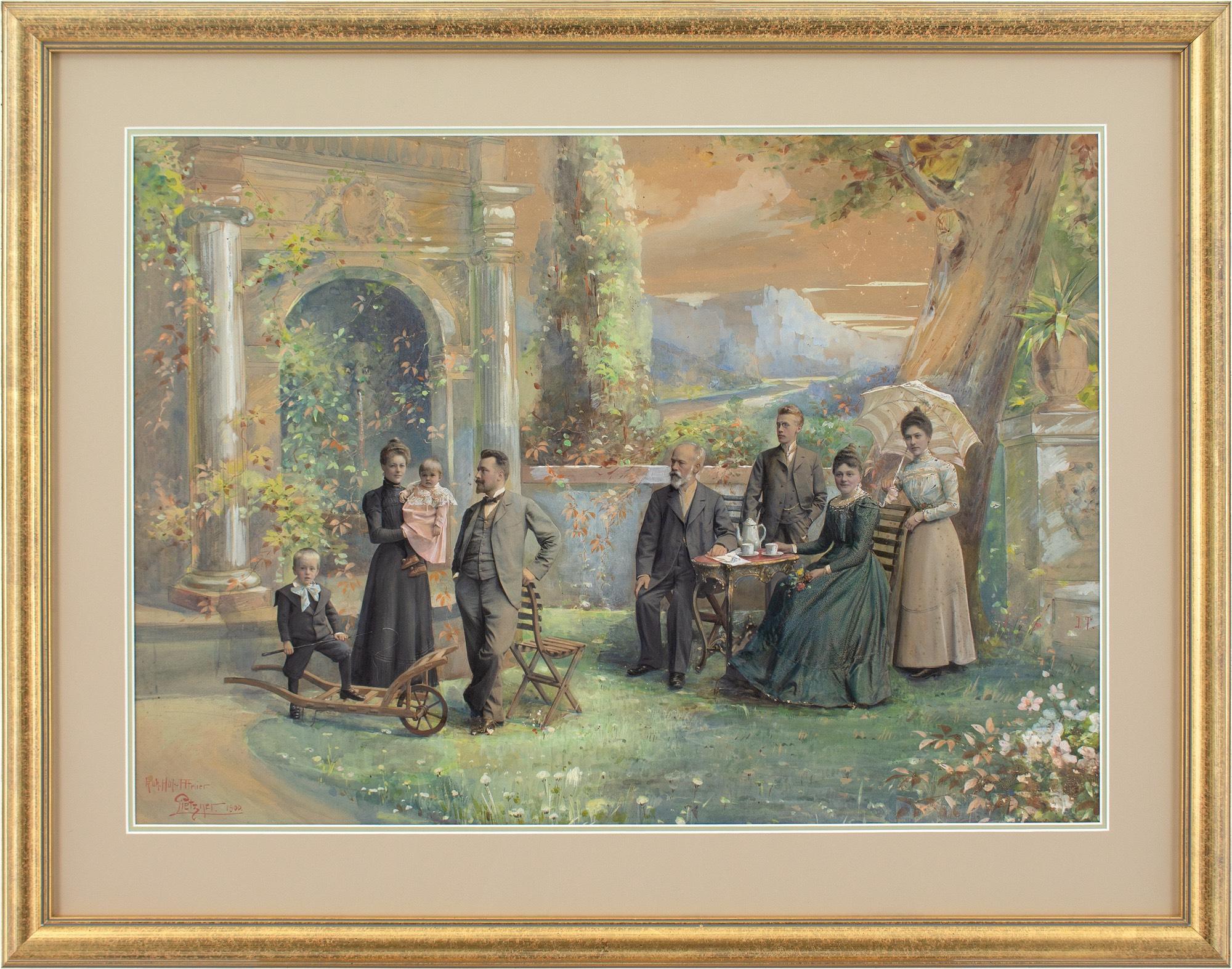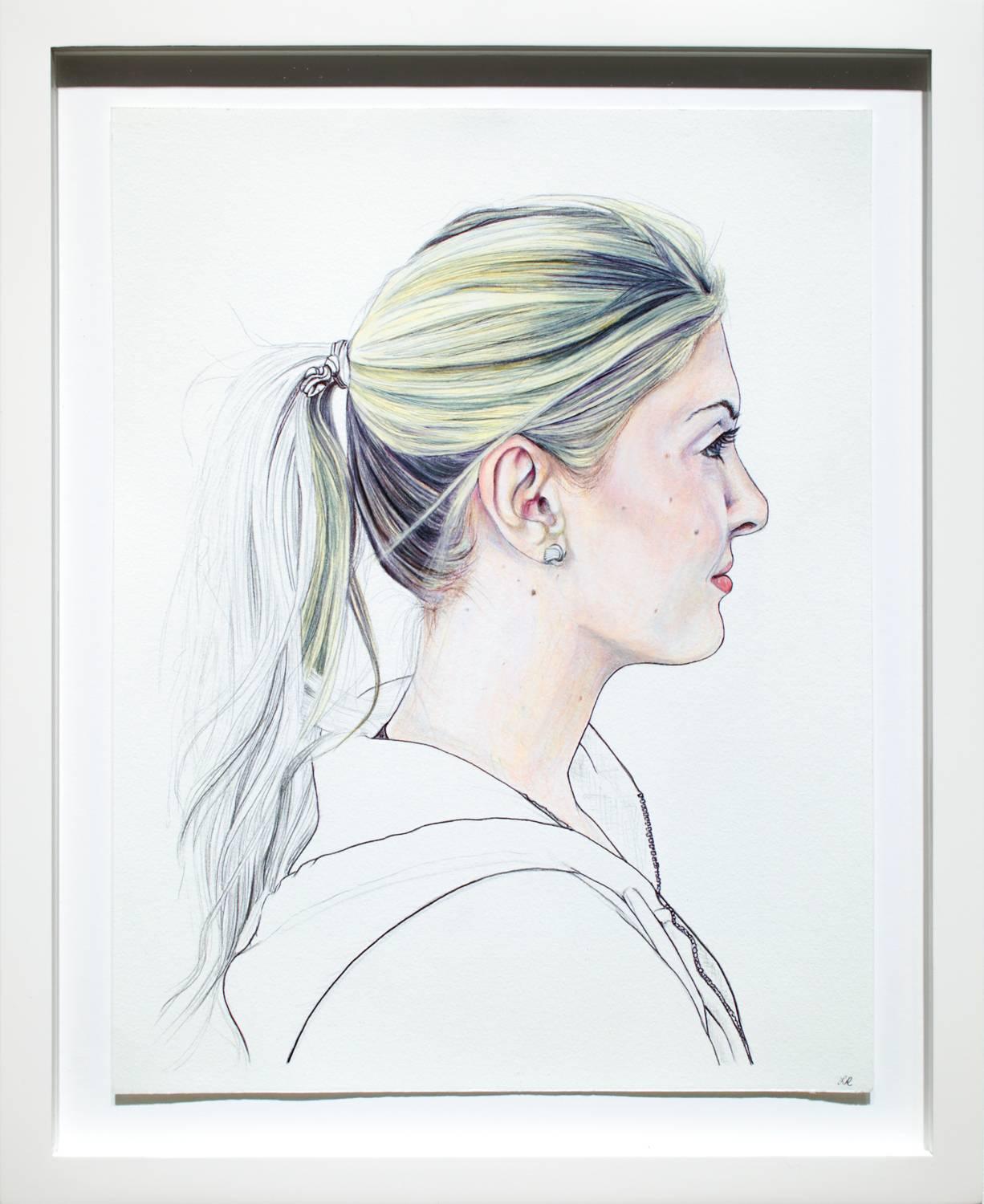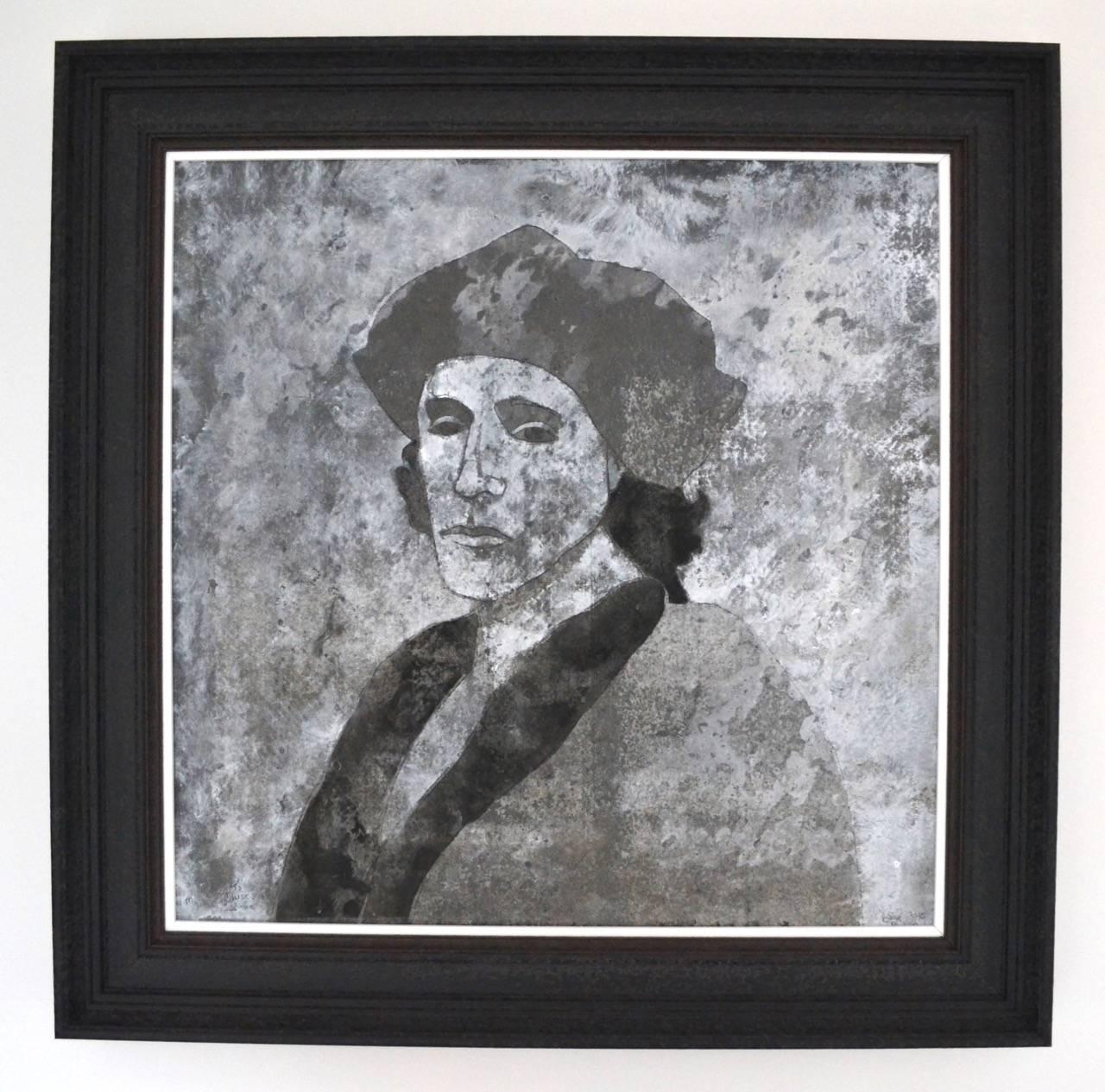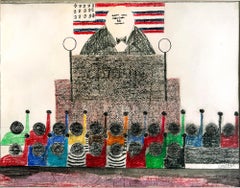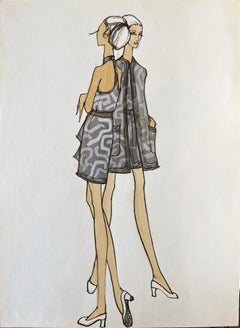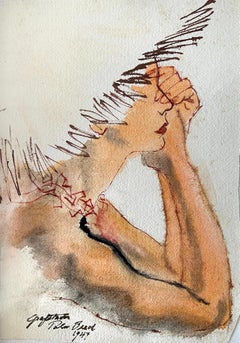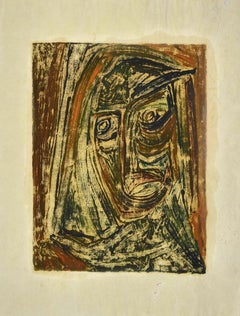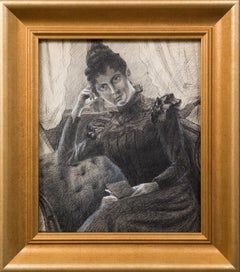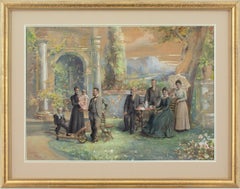Items Similar to Portrait of African Man by African American Artist Expressionist Brush Strokes
Video Loading
Want more images or videos?
Request additional images or videos from the seller
1 of 8
Vincent D. SmithPortrait of African Man by African American Artist Expressionist Brush Strokes1965
1965
About the Item
This Portrait of an African Man by an African American artist exhibits penetrating psychological insight and is executed in vibrant colors with quick gestural post-expressionist brushstrokes.
Signed lower right Vincent. Clearly Vincent Smith is giving a nod to Vincent Van Gogh.
Framed win period metal frame to framed size 20.25 x 15.25
- Creator:Vincent D. Smith (1929 - 2003, American)
- Creation Year:1965
- Dimensions:Height: 13 in (33.02 cm)Width: 9 in (22.86 cm)
- Medium:
- Movement & Style:
- Period:
- Condition:Artwork is very good - Frame is period but the mat has condition issues.
- Gallery Location:Miami, FL
- Reference Number:1stDibs: LU385314391772
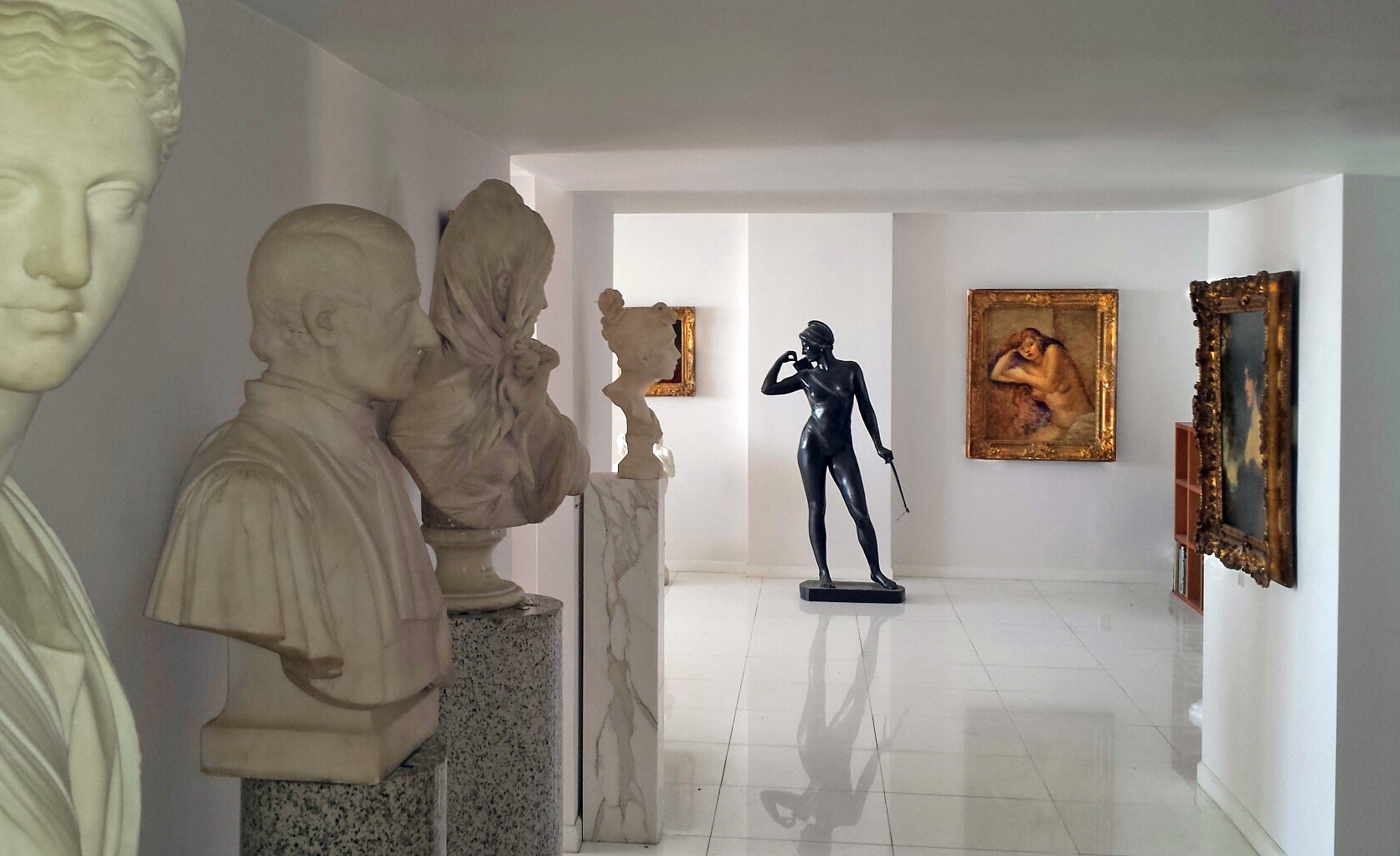
About the Seller
4.9
Vetted Seller
These experienced sellers undergo a comprehensive evaluation by our team of in-house experts.
Established in 2005
1stDibs seller since 2016
103 sales on 1stDibs
Typical response time: <1 hour
- ShippingRetrieving quote...Ships From: Miami, FL
- Return PolicyA return for this item may be initiated within 3 days of delivery.
Authenticity Guarantee
In the unlikely event there’s an issue with an item’s authenticity, contact us within 1 year for a full refund. DetailsMoney-Back Guarantee
If your item is not as described, is damaged in transit, or does not arrive, contact us within 7 days for a full refund. Details24-Hour Cancellation
You have a 24-hour grace period in which to reconsider your purchase, with no questions asked.Vetted Professional Sellers
Our world-class sellers must adhere to strict standards for service and quality, maintaining the integrity of our listings.Price-Match Guarantee
If you find that a seller listed the same item for a lower price elsewhere, we’ll match it.Trusted Global Delivery
Our best-in-class carrier network provides specialized shipping options worldwide, including custom delivery.More From This Seller
View AllBlack Panther Trials - Civil Rights Movement Police Violence African American
Located in Miami, FL
The Black Panther Trials - In this historically significant work, African American Artist Vicent D. Smith functions as an Art Journalist/ Court Reporter as much as a
Artist. Here, he depicts, in complete unity, 21 Black Panther Protestors raising their fist of defiance at the White Judge. Smith's composition is about utter simplicity, where the Black Panther Protestors are symmetrically lined up in a confrontation with a Judge whose size is exaggerated in scale. Set against a stylized American Flag, the supercilious Judge gazes down as the protesters as their fists thrust up. Signed Vincent lower right. Titled Panter 21. Original metal frame. Tape on upper left edge of frame. 255 . Panther 21. Framed under plexi.
_____________________________
From Wikipedia
In 1969-1971 there was a series of criminal prosecutions in New Haven, Connecticut, against various members and associates of the Black Panther Party.[1] The charges ranged from criminal conspiracy to first-degree murder. All charges stemmed from the murder of 19-year-old Alex Rackley in the early hours of May 21, 1969. The trials became a rallying-point for the American Left, and marked a decline in public support, even among the black community, for the Black Panther Party
On May 17, 1969, members of the Black Panther Party kidnapped fellow Panther Alex Rackley, who had fallen under suspicion of informing for the FBI. He was held captive at the New Haven Panther headquarters on Orchard Street, where he was tortured and interrogated until he confessed. His interrogation was tape recorded by the Panthers.[2] During that time, national party chairman Bobby Seale visited New Haven and spoke on the campus of Yale University for the Yale Black Ensemble Theater Company.[3] The prosecution alleged, but Seale denied, that after his speech, Seale briefly stopped by the headquarters where Rackley was being held captive and ordered that Rackley be executed. Early in the morning of May 21, three Panthers – Warren Kimbro, Lonnie McLucas, and George Sams, one of the Panthers who had come East from California to investigate the police infiltration of the New York Panther chapter, drove Rackley to the nearby town of Middlefield, Connecticut. Kimbro shot Rackley once in the head and McLucas shot him once in the chest. They dumped his corpse in a swamp, where it was discovered the next day. New Haven police immediately arrested eight New Haven area Black Panthers. Sams and two other Panthers from California were captured later.
Sams and Kimbro confessed to the murder, and agreed to testify against McLucas in exchange for a reduction in sentence. Sams also implicated Seale in the killing, telling his interrogators that while visiting the Panther headquarters on the night of his speech, Seale had directly ordered him to murder Rackley. In all, nine defendants were indicted on charges related to the case. In the heated political rhetoric of the day, these defendants were referred to as the "New Haven Nine", a deliberate allusion to other cause-celebre defendants like the "Chicago Seven".
The first trial was that of Lonnie McLucas, the only person who physically took part in the killing who refused to plead guilty. In fact, McLucas had confessed to shooting Rackley, but nonetheless chose to go to trial.
Jury selection began in May 1970. The case and trial were already a national cause célèbre among critics of the Nixon administration, and especially among those hostile to the actions of the FBI. Under the Bureau's then-secret "Counter-Intelligence Program" (COINTELPRO), FBI director J. Edgar Hoover had ordered his agents to disrupt, discredit, or otherwise neutralize radical groups like the Panthers. Hostility between groups organizing political dissent and the Bureau was, by the time of the trials, at a fever pitch. Hostility from the left was also directed at the two Panthers cooperating with the prosecutors. Sams in particular was accused of being an informant, and lying to implicate Seale for personal benefit.
In the days leading up to a rally on May Day 1970, thousands of supporters of the Panthers arrived in New Haven individually and in organized groups. They were housed and fed by community organizations and by sympathetic Yale students in their dormitory rooms. The Yale college dining halls provided basic meals for everyone. Protesters met daily en masse on the New Haven Green across the street from the Courthouse (and one hundred yards from Yale's main gate). On May Day there was a rally on the Green, featuring speakers including Jean Genet, Abbie Hoffman, Jerry Rubin, and John Froines (an assistant professor of chemistry at the University of Oregon). Teach-ins and other events were also held in the colleges themselves.
Towards midnight on May 1, two bombs exploded in Yale's Ingalls Rink, where a concert was being held in conjunction with the protests.[4] Although the rink was damaged, no one was injured, and no culprit was identified.[4]
Yale chaplain William Sloane Coffin stated, "All of us conspired to bring on this tragedy by law enforcement agencies by their illegal acts against the Panthers, and the rest of us by our immoral silence in front of these acts," while Yale President Kingman Brewster Jr. issued the statement, "I personally want to say that I'm appalled and ashamed that things should have come to such a pass that I am skeptical of the ability of a Black revolutionary to receive a fair trial anywhere in the U.S." Brewster's generally sympathetic tone enraged many of the university's older, more conservative alumni, heightening tensions within the school community.
As tensions mounted, Yale officials sought to avoid deeper unrest and to deflect the real possibility of riots or violent student demonstrations. Sam Chauncey has been credited with winning tactical management on behalf of the administration to quell anxiety among law enforcement and New Haven's citizens, while Kurt Schmoke, a future Rhodes Scholar, mayor of Baltimore, MD and Dean of Howard University School of Law, has received kudos as undergraduate spokesman to the faculty during some of the protest's tensest moments. Ralph Dawson, a classmate of Schmoke's, figured prominently as moderator of the Black Student Alliance at Yale (BSAY).
In the end, compromises between the administration and the students - and, primarily, urgent calls for nonviolence from Bobby Seale and the Black Panthers themselves - quashed the possibility of violence. While Yale (and many other colleges) went "on strike" from May Day until the end of the term, like most schools it was not actually "shut down". Classes were made "voluntarily optional" for the time and students were graded "Pass/Fail" for the work done up to then.
Trial of McLucas
Black Panther trial sketch...
Category
1970s American Modern Figurative Drawings and Watercolors
Materials
Watercolor, Pen, Pencil, Paper
Fashion Illustration with Two Leggy Models in Monochromatic Greys
Located in Miami, FL
Two elegant and leggy models are rendered and meticulously designed in this illustration for Geoffrey Beene. Miyake's composition is one model as two or two models as one. We see th...
Category
1960s Contemporary Figurative Drawings and Watercolors
Materials
Watercolor, Permanent Marker, Carbon Pencil
Glamorous Palm Beach Portrait with Sun Hat - Mid Century Female Illustrator
By Ruth Sigrid Grafstrom
Located in Miami, FL
The mid-century glamour portrait of an elegant, long-necked woman in silhouette with a straw sun hat. Signed and dated Grafstrom Palm Beach 1947 - Condition is good with some scatter...
Category
1940s Impressionist Portrait Drawings and Watercolors
Materials
Watercolor, Pen
The Little Mermaid - Fairy Tales - English Female Illustrator Pen and Ink
Located in Miami, FL
Pioneering English Female Illustrator Helen Stratton masterfully renders in pen and ink a scene from "The Little Mermaid" in George Newnes's 1899 editi...
Category
1890s Pre-Raphaelite Figurative Drawings and Watercolors
Materials
Ink, Paper, Pen
Hand-Me-Downs - Street Children - Waif - Cockney Gutter Imps.
Located in Miami, FL
19th Century Street Art - British children's book author and illustrator Edith Farmiloe depicts a waif-like girl - Cockney Gutter Imp - who is disheveled. The artist draws her i...
Category
Early 1900s Romantic Figurative Drawings and Watercolors
Materials
Paper, Ink, Pen
Frolic Club IV - New York City in the 1960's - Strip Club Gritty Social Realism
By Philip Reisman
Located in Miami, FL
Philip Reisman paints the raw street life of New York City. Whether he's painting a barmaid or a street hobo, Reisman is a people painter. He studied at the Art Students League with ...
Category
1960s American Realist Portrait Drawings and Watercolors
Materials
Paper, Watercolor
You May Also Like
Portrait - Drawing on Paper by Sebastiano Carta - 1950s
By Sebastiano Carta 1
Located in Roma, IT
Portrait is an original Mixed media drawing on paper, realized by Sebastiano Carta.
In good conditions except for some diffused foldings.
Hand-signed on the lower left margin in pe...
Category
1950s Expressionist Mixed Media
Materials
Mixed Media
Portrait - Drawing on Paper by Sebastiano Carta - 1950s
By Sebastiano Carta 1
Located in Roma, IT
Portrait is an original mixed media drawing on paper realized by Sebastiano Carta.
In good conditions except for some diffused foldings.
Hand-signed on the lower left margin in pen...
Category
1950s Expressionist Mixed Media
Materials
Mixed Media
Portrait of Hulda in a Room at Ruds Säteri
Located in Stockholm, SE
Hilding Werner (1880-1944) Sweden
Hulda in a Room at Ruds Säteri
mixed media on paper
unframed 27 x 22.5 cm (10.63 x 8.86 inches)
framed 38 x 33.5 cm (14.96 x 13.19 inches)
Prov...
Category
Early 20th Century Mixed Media
Materials
Paper, Ink, Watercolor
K & K Hof Atelier Pietzner, Family Portrait In A Garden Setting
Located in Cheltenham, GB
This early 20th-century mixed media by K & K Hof Atelier Pietzner of Vienna depicts a respectable family within a neoclassical garden setting.
With the advent of photography, afflue...
Category
Early 1900s Art Nouveau Mixed Media
Materials
Paper, Watercolor, Gouache, Photographic Paper
"Control C" Colored pencil, pen, graphite on paper
By Lauren Rinaldi
Located in Philadelphia, PA
Original drawing by Lauren Rinaldi float mounted in the pictured simple white frame measuring 17in x 14in. This is an original artwork made with colored pencil, ballpoint pen, graphi...
Category
21st Century and Contemporary Contemporary Portrait Drawings and Waterco...
Materials
Archival Paper, Ballpoint Pen, Graphite, Oil Pastel
Mask Of Rylance. Contemporary Gouache on Italian Slate
By Sax Berlin
Located in Brecon, Powys
Portrait of British actor Mark Rylance in his now famous role as Thomas Cromwell.
Gouache on Italian slate. Well framed in ornate black wood frame.
Framed 30" x 30" Image 23' x 23"
Category
21st Century and Contemporary Contemporary Mixed Media
Materials
Slate
Recently Viewed
View AllMore Ways To Browse
Artist Brushes
Used Artist Brushes
Used Artists Brushes
Brush Stroke
African Artist Painting
Brush Stroke Art
Art By African American
Africa Portrait
African American Artists
African American Vintage
Vintage African American Art
African American Art Signed
African American Paintings
Paintings Of African Americans
African American Art Paintings
Vintage Artists Brushes
African American Artist Painting
African American Portrait



